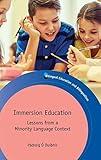Immersion Education : Practices, Policies, Possibilities / ed. by Diane J. Tedick, Donna Christian, Tara Williams Fortune.
Material type: TextSeries: Bilingual Education & BilingualismPublisher: Bristol ; Blue Ridge Summit : Multilingual Matters, [2011]Copyright date: ©2011Description: 1 online resource (304 p.)Content type:
TextSeries: Bilingual Education & BilingualismPublisher: Bristol ; Blue Ridge Summit : Multilingual Matters, [2011]Copyright date: ©2011Description: 1 online resource (304 p.)Content type: - 9781783099832
- 9781847694041
- 418.0071 22
- P53.44 .I44 2011eb
- online - DeGruyter
| Item type | Current library | Call number | URL | Status | Notes | Barcode | |
|---|---|---|---|---|---|---|---|
 eBook
eBook
|
Biblioteca "Angelicum" Pont. Univ. S.Tommaso d'Aquino Nuvola online | online - DeGruyter (Browse shelf(Opens below)) | Online access | Not for loan (Accesso limitato) | Accesso per gli utenti autorizzati / Access for authorized users | (dgr)9781847694041 |
Frontmatter -- Contents -- Acknowledgements -- Contributors -- Foreword -- Introduction to the Volume -- Chapter 1. The Future of Immersion Education: An Invitation to ‘Dwell in Possibility’ -- Part 1: Practices in Immersion Program Design -- Chapter 2. Integrating Multiple Languages in Immersion: Swedish Immersion in Finland -- Chapter 3. Insights from Indigenous Language Immersion in Hawai‘i -- Chapter 4. Two-Way Immersion Charter Schools: An Analysis of Program Characteristics and Student Body Compositions -- Part 2: Program Outcomes and Implications for Practice -- Chapter 5. Student Outcomes in Chinese Two-Way Immersion Programs: Language Proficiency, Academic Achievement and Student Attitudes -- Chapter 6. The Same Outcomes for All? High-School Students Reflect on Their Two-Way Immersion Program Experiences -- Chapter 7. French Immersion Studies at the University of Ottawa: Programme Evaluation and Pedagogical Challenges -- Part 3: Language Use and Assessment Practices in Immersion Programs -- Chapter 8. ‘I Thought That We Had Good Irish’: Irish Immersion Students’ Insights into Their Target Language Use -- Chapter 9. Talking in the Fifth-Grade Classroom: Language Use in an Early, Total Spanish Immersion Program -- Chapter 10. Using Language Assessment to Inform Instruction in Indigenous Language Immersion -- Part 4: Policy and Practice in Immersion Education -- Chapter 11. Context and Constraints: Immersion in Hong Kong and Mainland China -- Chapter 12. US Immigrants and Two-Way Immersion Policies: The Mismatch between District Designs and Family Experiences -- Chapter 13. Struggling Learners and the Language Immersion Classroom -- Concluding Synthesis Chapter for the Volume -- Chapter 14. Reflecting on Possibilities for Immersion -- Index
restricted access online access with authorization star
http://purl.org/coar/access_right/c_16ec
This volume builds on Fortune and Tedick’s 2008 Pathways to Multilingualism: Evolving Perspectives on Immersion Education and showcases the practice and promise of immersion education through in-depth investigations of program design, implementation practices, and policies in one-way, two-way and indigenous programs. Contributors present new research and reflect on possibilities for strengthening practices and policies in immersion education. Questions explored include: What possibilities for program design exist in charter programs for both two-way and indigenous models? How do studies on learner outcomes lead to possibilities for improvements in program implementation? How do existing policies and practices affect struggling immersion learners and what possibilities can be imagined to better serve such learners? In addressing such questions, the volume invites readers to consider the possibilities of immersion education to enrich the language development and educational achievement of future generations of learners.
Mode of access: Internet via World Wide Web.
In English.
Description based on online resource; title from PDF title page (publisher's Web site, viewed 01. Dez 2022)


